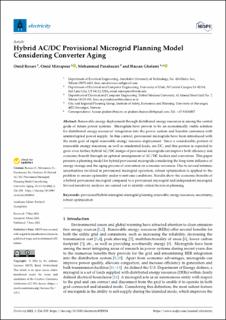| dc.contributor.author | Rezaei, Omid | |
| dc.contributor.author | Mirzapour, Omid | |
| dc.contributor.author | Panahazari, Mohammad | |
| dc.contributor.author | Gholami, Hassan | |
| dc.date.accessioned | 2022-07-07T07:55:56Z | |
| dc.date.available | 2022-07-07T07:55:56Z | |
| dc.date.created | 2022-06-09T13:17:48Z | |
| dc.date.issued | 2022-06 | |
| dc.identifier.citation | Rezaei, O., Mirzapour, O., Panahazari, M., & Gholami, H. (2022). Hybrid AC/DC Provisional Microgrid Planning Model Considering Converter Aging. Electricity, 3(2), 236–250. | en_US |
| dc.identifier.issn | 2673-4826 | |
| dc.identifier.uri | https://hdl.handle.net/11250/3003374 | |
| dc.description.abstract | Building integrated photovoltaics is one of the key technologies when it comes to electricity generation in buildings, districts or urban areas. However, the potential of building façades for the BIPV system, especially in urban areas, is often neglected. Façade-mounted building integrated photovoltaics could contribute to supply the energy demand of buildings in dense urban areas with economic feasibility where the availability of suitable rooftop areas is low. This paper deals with the levelised cost of electricity (LCOE) of building integrated photovoltaic systems (BIPV) in the capitals of all the European member state countries plus Norway and Switzerland and presents a metric to investigate a proper subsidy or incentive for BIPV systems. The results showed that the average LCOE of the BIPV system as a building envelope material for the entire outer skin of buildings in Europe is equal to 0.09 Euro per kWh if its role as the power generator is considered in the economic calculations. This value will be 0.15 Euro per kWh if the cost corresponding to its double function in the building is taken into the economic analysis (while the average electricity price is 0.18 Euro per kWh). The results indicate that the BIPV generation cost in most case studies has already reached grid parity. Furthermore, the analysis reveals that on average in Europe, the BIPV system does not need a feed-in tariff if the selling price to the grid is equal to the purchasing price from the grid. Various incentive plans based on the buying/selling price of electricity from/to the main grid together with LCOE of the BIPV systems is also investigated. View Full-Text | en_US |
| dc.language.iso | eng | en_US |
| dc.publisher | MDPI | en_US |
| dc.relation.uri | https://www.mdpi.com/2673-4826/3/2/14 | |
| dc.rights | Navngivelse 4.0 Internasjonal | * |
| dc.rights.uri | http://creativecommons.org/licenses/by/4.0/deed.no | * |
| dc.subject | microgrid | en_US |
| dc.subject | elektrisitet | en_US |
| dc.title | Hybrid AC/DC Provisional Microgrid Planning Model Considering Converter Aging | en_US |
| dc.type | Peer reviewed | en_US |
| dc.type | Journal article | en_US |
| dc.description.version | publishedVersion | en_US |
| dc.rights.holder | © 2022 by the authors | en_US |
| dc.subject.nsi | VDP::Teknologi: 500::Elektrotekniske fag: 540 | en_US |
| dc.source.pagenumber | 236-250 | en_US |
| dc.source.volume | 3 | en_US |
| dc.source.journal | Electricity | en_US |
| dc.source.issue | 2 | en_US |
| dc.identifier.doi | 10.3390/electricity3020014 | |
| dc.identifier.cristin | 2030491 | |
| cristin.ispublished | true | |
| cristin.fulltext | original | |
| cristin.qualitycode | 1 | |

